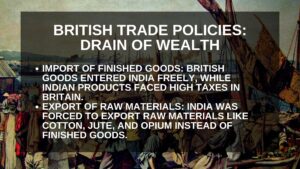The British rule in India brought significant changes to the country’s economic structure. Unlike previous rulers who became a part of the Indian economy, the British exploited India’s resources and wealth without integrating into the system. Let’s understand the major economic impact of British rule in India.
1. De-industrialization: Decline of Indian Artisans and Craftsmen
The British deliberately destroyed India’s traditional industries for their benefit.
- One-way Free Trade Policy: In 1813, the British imposed a trade policy that allowed British goods to enter India without restrictions, while Indian exports to Britain were taxed heavily.
- Industrial Revolution in Britain: Cheap machine-made goods from Britain flooded the Indian markets, destroying India’s handicraft industry.
- Loss of Royal Patronage: Indian rulers and their courts were major patrons of handicrafts. With their decline, artisans lost their livelihood.
- Absence of Technology: Unlike Europe, India did not see a technological revolution. As a result, traditional industries collapsed, and modern industries did not emerge.
Millions of artisans lost their jobs and were forced to become farm laborers, increasing the burden on agriculture and worsening poverty.
Download notes of Annexation of Sindh and Punjab by the British
2. Impoverishment of the Peasantry and Rise of New Landlords
The British introduced exploitative land revenue systems like the Permanent Settlement, Ryotwari, and Mahalwari systems.
- Loss of Land Rights: Tenants lost their traditional rights over land, leading to insecurity.
- Triple Burden: Peasants had to pay high taxes to the British government, landlords (zamindars), and moneylenders.
- Neglect of Agricultural Development: There was little effort to improve agricultural productivity, leading to repeated peasant uprisings.
3. Stagnation and Deterioration of Agriculture
Agriculture suffered due to heavy taxation, land fragmentation, and debt-ridden farmers.
- Lack of Modern Technology: Due to extreme poverty, farmers could not invest in better farming techniques.
- Forced Commercialization: The British forced farmers to grow commercial crops (like indigo and opium) instead of food grains, leading to food shortages.
- Exposure to Global Market: Peasants became vulnerable to international price fluctuations, further worsening their condition.
4. Poverty and Famines
Extreme poverty became a characteristic of British rule due to:
- Decline of local industries.
- High taxation and wealth drain to Britain.
- Stagnant agriculture and exploitation by landlords.
The result was a series of devastating famines:
- 1860-61: Over 2 lakh deaths in Western Uttar Pradesh.
- 1865-66: Bengal famine led to 20 lakh deaths.
- 1876-78: One of the worst famines in history killed millions.
- 1896-97 and 1899-1900: Famines caused lakhs of deaths.
- 1943 Bengal Famine: Around 3 million people died due to food shortages and British negligence.
Additionally, diseases like the 1918 Spanish flu killed over 15 million Indians.
5. Development of Modern Industries
In the late 19th century, some modern industries emerged, like:
- Textile Industry: First textile mill in Bombay in 1853.
- Jute and Coal Mining Industries: Developed but mostly controlled by the British.
- Iron & Steel Industry: Began in early 20th century but remained limited.
Challenges for Indian Industries:
- British Dominance: Most industries were owned by British capitalists.
- Lack of Credit: Indian businessmen struggled to get loans due to the dominance of British banks.
- No Heavy Industries: India lacked capital goods industries like steel, oil, and chemicals.
- Plantation Industry: British-controlled tea, coffee, and indigo plantations exploited workers and sent profits abroad.
6. British Trade Policies: Drain of Wealth
After 1813, Britain followed a free trade policy that harmed Indian industries.
- Import of Finished Goods: British goods entered India freely, while Indian products faced high taxes in Britain.
- Export of Raw Materials: India was forced to export raw materials like cotton, jute, and opium instead of finished goods.

The economic policies transformed India into a raw material supplier for British industries, destroying self-sufficiency.
7. Development of Railways and Communication
Railways:
- Introduced in 1853 under Lord Dalhousie.
- Built mainly to transport raw materials to ports for British industries.
- Helped in food grain exports but worsened famines.
- Spread diseases like cholera and influenza.
Post and Telegraph:
- Postal service: Started by Warren Hastings in 1766, later expanded by Lord Dalhousie in 1854.
- Telegraph service: Introduced in 1851, helped suppress the 1857 Revolt.
- Helped British control India but also aided in national movements by spreading patriotic ideas.
8. Labour Policies and Indentured Labour System
Indian workers faced miserable conditions in British-owned industries.
- Factory Workers:
- Worked 12-16 hours daily without weekly rest.
- Women and children were exploited.
- Poor wages and unsafe conditions.
Labour Reforms:
- First Factory Act (1881): Limited child labor.
- Second Labour Act (1891): Introduced weekly holidays and fixed 11-hour shifts for women.
- Royal Commission on Labour (1929): Investigated plantation workers’ conditions.
Indentured Labour System:
- Indians were sent to work in British plantations in the Caribbean, Fiji, and Mauritius.
- Many were tricked into migrating and worked in slave-like conditions.
- System was finally abolished in 1921 after nationalist protests.
9. British Policy on Press Freedom
- Modern Press Began: Printing press introduced by the British.
- Press and Freedom Struggle: Newspapers spread nationalist ideas.
- Vernacular Press Act (1878): Restricted freedom of Indian newspapers.
- Repealed in 1882: After opposition from Indian leaders.
- Further Press Censorship (1908, 1910): After the Swadeshi movement.
Download notes of Administrative Unification Under British Rule in India
The British rule led to the exploitation of India’s resources, destruction of traditional industries, extreme poverty, and frequent famines. Although some modern industries and infrastructure developed, they were designed to serve British interests. The economic policies of the British kept India dependent and underdeveloped, making independence a necessity.


